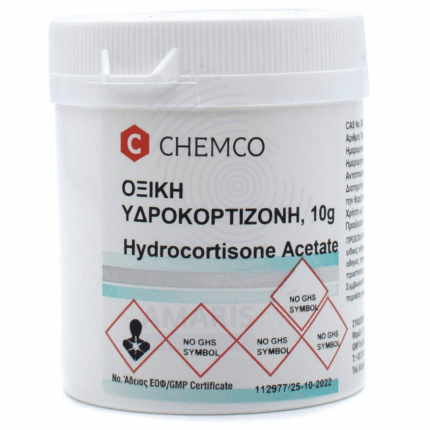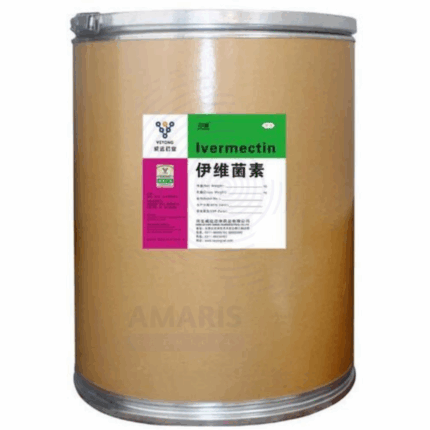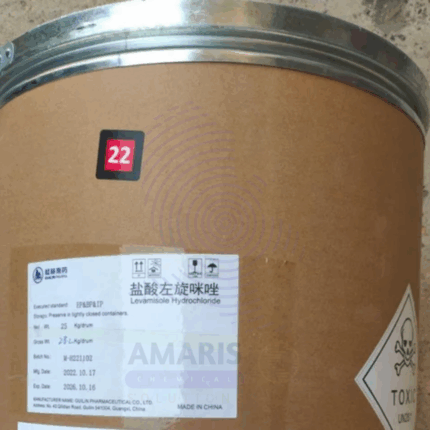Enrofloxacin Hydrochloride
Enrofloxacin Hydrochloride is a broad-spectrum fluoroquinolone antibiotic used primarily in veterinary medicine. It is the hydrochloride salt of enrofloxacin, offering enhanced solubility and bioavailability. Enrofloxacin inhibits bacterial DNA gyrase and topoisomerase IV, disrupting DNA replication in Gram-negative and Gram-positive organisms as well as some Mycoplasma species. It is available as a white to off-white crystalline powder, used in injectable, oral, and topical formulations designed for livestock, companion animals, and aquatic species.
Enrofloxacin Hydrochloride
Primary Uses
- Veterinary Medicine
- Companion Animals (Dogs & Cats): Treats skin, soft tissue, urinary, respiratory, and gastrointestinal infections caused by susceptible bacteria.
- Livestock (Cattle, Pigs, Sheep): Administered to treat respiratory diseases (e.g., bovine respiratory disease), mastitis, foot rot, and gastrointestinal infections.
- Poultry & Aquaculture: Used for bacterial infections in fish and poultry when acute outbreaks occur.
- Preventive Use: Employed under veterinary supervision for surgical prophylaxis or after trauma to prevent infection.
- Pharmaceutical & Research Applications
- Drug Formulation Development: Used in studies to improve dosage forms (injectable, tablet, bolus, topical).
- Antimicrobial Resistance Research: Included in studies assessing bacterial resistance trends and mechanisms.
- Veterinary Clinical Trials: Serves as a reference antibiotic for testing novel treatments.
Secondary Uses
- Exotic and Zoo Animals
- Used off-label under veterinary guidance to treat infections in exotic pets, wildlife rehabilitation, and zoo species.
- Antibacterial Sensitivity Testing
- Employed in culture and sensitivity panels to determine susceptibility of veterinary pathogens.
1. Basic Identification Attributes
- Chemical Name (IUPAC): 1-cyclopropyl-7-(4‑ethylpiperazin-1‑yl)-6-fluoro-4-oxo-1,4‑dihydroquinoline-3-carboxylic acid hydrochloride
- Common/Trade Name: Enrofloxacin HCl
- CAS Number: 93106-60-6
- HS Code: 2941.30.00
- Molecular Formula: C19H22FN3O3·HCl
- Synonyms:
- Enrofloxacin hydrochloride
- Flumequine analog
- Enro-HCl
2. Physical & Chemical Properties
- Physical State: White to off-white crystalline powder
- Odor: Odorless
- Melting Point: Approx. 228–235 °C (with decomposition)
- Solubility: Soluble in water, ethanol, and methanol; rarely soluble in non-polar solvents
- pH (1% aqueous): Typically ~4.5–5.5
- Stability: Stable in dry form under ambient conditions; sensitive to light, strong acids, and bases
3. Safety & Hazard Attributes
- Hazard Class (GHS): Not classed as hazardous, but may cause sensitization
- Toxicity: Moderate; may cause gastrointestinal, CNS effects, and photosensitivity in animals
- Exposure Limits: No specific occupational limits; use standard laboratory hygiene
4. Storage & Handling Attributes
- Storage Conditions: Store in airtight containers at 2–8 °C in dark, dry conditions
- Container Type: Amber glass bottles or HDPE containers
- Shelf Life: 2–3 years if tightly sealed and temperature-controlled
- Handling Precautions: Avoid dust inhalation, skin contact; use PPE to prevent cross-contamination
5. Regulatory & Compliance Attributes
- Regulatory Approvals: Listed in veterinary pharmacopeias (USP Vet, Ph. Eur.)
- Residue Monitoring: Subject to MRLs for milk and meat withdrawal periods
- Prescription Status: Veterinary prescription-only in most countries
- REACH/TSCA Status: Registered in jurisdictions where required
6. Environmental & Health Impact
- Biodegradability: Partial; may persist in soil and water
- Ecotoxicity: Toxic to fish and aquatic invertebrates; avoid releasing effluents
- Bioaccumulation: Potential for accumulation in aquatic tissues
- Carcinogenicity/Mutagenicity: Not classified; safety based on animal data only
Safety Handling Precautions
PPE Required:
- Nitrile gloves
- Safety goggles
- Lab coat
- Dust mask or respirator when handling bulk powder
Handling Guidelines:
- Work in a ventilated area
- Avoid inhalation of dust and skin contact
- Minimize aerosol generation
- Use clean equipment and avoid cross-contamination
Storage Measures:
- Keep containers sealed and refrigerated (2–8 °C)
- Protect from light, moisture, and heat
- Store separately from incompatible substances (strong acids, oxidizers)
Hygiene Practices:
- Wash hands thoroughly after handling
- Do not eat, drink, or smoke in the facility
- Change out contaminated clothing and launder separately
First Aid Measures
- Inhalation: Move to fresh air; seek medical attention if respiratory symptoms develop
- Skin Contact: Wash with soap and water; seek medical advice if rash or irritation occurs
- Eye Contact: Rinse eyes with water for 15 minutes; seek medical advice if irritation persists
- Ingestion: Rinse mouth; do not induce vomiting; seek veterinary or human medical attention as applicable
Firefighting Measures
- Fire Hazards: Combustible powder; may produce dense smoke when exposed to high heat
- Extinguishing Media: Foam, dry chemical, CO₂, or water spray
- Special Precautions: Use proper respiratory protection during firefighting
- Decomposition Products: May emit nitrogen oxides, hydrogen chloride, CO, and CO₂
Related products
Cetirizine Hydrochloride (Cetirizine HCl)
Chlorpheniramine Maleate
Diphenhydramine HCL BP
Hydrocortisone Acetate
Ivermectin BP Vet
Levamisole Hcl BP2000
Mepyramine Maleate BP
Miconazole Nitrate BP
Miconazole Nitrate BP is a high-purity, pharmaceutical-grade antifungal agent conforming to British Pharmacopoeia (BP) specifications. It is widely used in the formulation of topical and oral pharmaceutical products for the treatment of fungal infections caused by dermatophytes and yeasts, including Candida species. Miconazole Nitrate functions by inhibiting the biosynthesis of ergosterol, a vital component of fungal cell membranes, leading to cell death.
This white to off-white crystalline powder is highly effective and exhibits broad-spectrum antifungal and some antibacterial activity. It is commonly utilized in creams, ointments, powders, and gel formulations.


 Preservatives(food)
Preservatives(food) Flavor Enhancers
Flavor Enhancers Acidulants
Acidulants Sweeteners
Sweeteners Antioxidants
Antioxidants Colorants(food)
Colorants(food) Nutraceutical Ingredients (food)
Nutraceutical Ingredients (food) Nutrient Supplements
Nutrient Supplements Emulsifiers
Emulsifiers
 Collectors
Collectors Dust Suppressants
Dust Suppressants Explosives and Blasting Agents
Explosives and Blasting Agents Flocculants and Coagulants
Flocculants and Coagulants Frothers
Frothers Leaching Agents
Leaching Agents pH Modifiers
pH Modifiers Precious Metal Extraction Agents
Precious Metal Extraction Agents
 Antioxidants(plastic)
Antioxidants(plastic) Colorants (Pigments, Dyes)
Colorants (Pigments, Dyes) Fillers and Reinforcements
Fillers and Reinforcements Flame Retardants
Flame Retardants Monomers
Monomers Plasticizers
Plasticizers Polymerization Initiators
Polymerization Initiators Stabilizers (UV, Heat)
Stabilizers (UV, Heat)
 Antifoaming Agents
Antifoaming Agents Chelating Agents
Chelating Agents Coagulants and Flocculants
Coagulants and Flocculants Corrosion Inhibitors
Corrosion Inhibitors Disinfectants and Biocides
Disinfectants and Biocides Oxidizing Agents
Oxidizing Agents pH Adjusters
pH Adjusters Scale Inhibitors( water)
Scale Inhibitors( water)
 Antioxidants(cosmetic)
Antioxidants(cosmetic) Emollients
Emollients Fragrances and Essential Oils
Fragrances and Essential Oils Humectants
Humectants Preservatives
Preservatives Surfactants(cosmetic)
Surfactants(cosmetic) Thickeners
Thickeners UV Filters
UV Filters
 Fertilizers
Fertilizers Soil Conditioners
Soil Conditioners Plant Growth Regulators
Plant Growth Regulators Animal Feed Additives
Animal Feed Additives Biostimulants
Biostimulants Pesticides (Herbicides, Insecticides, Fungicides)
Pesticides (Herbicides, Insecticides, Fungicides)
 Active Pharmaceutical Ingredients (APIs)
Active Pharmaceutical Ingredients (APIs) Excipients
Excipients Solvents(pharmaceutical)
Solvents(pharmaceutical) Antibiotics
Antibiotics Antiseptics and Disinfectants
Antiseptics and Disinfectants Vaccine Adjuvants
Vaccine Adjuvants Nutraceutical Ingredients (pharmaceutical)
Nutraceutical Ingredients (pharmaceutical) Analgesics & Antipyretics
Analgesics & Antipyretics
 Analytical Reagents
Analytical Reagents Solvents(lab)
Solvents(lab) Chromatography Chemicals
Chromatography Chemicals Spectroscopy Reagents
Spectroscopy Reagents microbiology-and-cell-culture-reagents
microbiology-and-cell-culture-reagents Molecular Biology Reagents
Molecular Biology Reagents Biochemical Reagents
Biochemical Reagents Inorganic and Organic Standards
Inorganic and Organic Standards Laboratory Safety Chemicals
Laboratory Safety Chemicals Specialty Laboratory Chemicals(Special Laboratory Equipment)
Specialty Laboratory Chemicals(Special Laboratory Equipment)
 Demulsifiers
Demulsifiers Hydraulic Fracturing Fluids
Hydraulic Fracturing Fluids Scale Inhibitors(oil)
Scale Inhibitors(oil) Surfactants(oil)
Surfactants(oil) Drilling Fluids
Drilling Fluids
 Dyes and Pigments
Dyes and Pigments Bleaching Agents
Bleaching Agents Softening Agents
Softening Agents Finishing Agents
Finishing Agents Antistatic Agents
Antistatic Agents
 Admixtures
Admixtures Waterproofing Agents
Waterproofing Agents Sealants and Adhesives
Sealants and Adhesives Curing Compounds
Curing Compounds Concrete Repair Chemicals
Concrete Repair Chemicals Anti-Corrosion Coatings
Anti-Corrosion Coatings
 Surfactants(cleaning)
Surfactants(cleaning) Builders
Builders Enzymes
Enzymes Solvents (Cleaning)
Solvents (Cleaning) Fragrances
Fragrances
 Electronic Chemicals
Electronic Chemicals Catalysts
Catalysts Lubricants
Lubricants Photographic Chemicals
Photographic Chemicals Refrigerants
Refrigerants Automotive chemicals
Automotive chemicals Pyrotechnic Chemicals
Pyrotechnic Chemicals
 Biodegradable Surfactants
Biodegradable Surfactants Bio-based Solvents
Bio-based Solvents Renewable Polymers
Renewable Polymers Carbon Capture Chemicals
Carbon Capture Chemicals Wastewater Treatment Chemicals
Wastewater Treatment Chemicals
 Pigments
Pigments Solvents(paint)
Solvents(paint) Specialty Coatings
Specialty Coatings Binders/Resins
Binders/Resins Additives
Additives Driers
Driers Anti-Corrosion Agents
Anti-Corrosion Agents Functional Coatings
Functional Coatings Application-Specific Coatings
Application-Specific Coatings
 Fresh Herbs
Fresh Herbs Ground Spices
Ground Spices Whole Spices
Whole Spices Spice Blends
Spice Blends Dried Herbs
Dried Herbs
 Leavening Agents
Leavening Agents Dough Conditioners
Dough Conditioners Flour Treatments
Flour Treatments Fat Replacers
Fat Replacers Decoratives
Decoratives Preservatives(baking)
Preservatives(baking)
 Plasticizers & Softeners
Plasticizers & Softeners Reinforcing Agents
Reinforcing Agents Adhesion Promoters
Adhesion Promoters Vulcanizing Agents
Vulcanizing Agents Antidegradants
Antidegradants Blowing Agents
Blowing Agents Fillers & Extenders
Fillers & Extenders Accelerators & Retarders
Accelerators & Retarders























